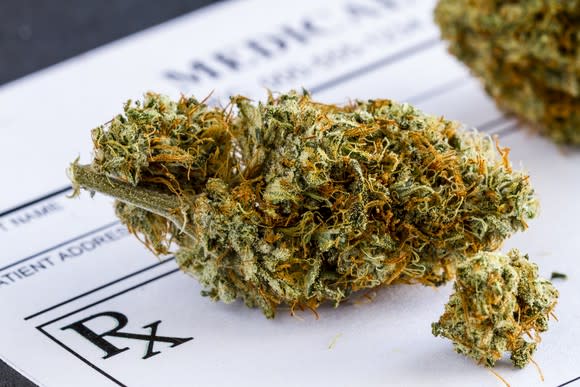2018's 3 Biggest Catalysts for Marijuana Stocks
Forget seeing marijuana stocks go up in smoke in 2017. They've been smoking hot.
According to cannabis research firm ArcView, the North American legal weed industry is expected to grow by 26% a year through 2021. If this proves the case, we could be talking about nearly $22 billion in sales by 2021. Finding consistent growth like this is tough to come by, which is why marijuana-stock investors have flocked to the industry, and why many of these stocks have doubled or tripled in value this year.

Image source: Getty Images.
Also working in favor of cannabis stocks is that public support for weed has improved significantly over the past two decades. In 1995, national pollster Gallup found that a mere 25% of U.S. respondents were in favor of legalizing marijuana nationally. Comparatively, an all-time record 64% of survey-takers were in support of legalization as of October 2017.
But the big question on the minds of investors is: What does 2018 hold for the marijuana industry? In the coming year, three catalysts are likely to take precedence, ultimately guiding the performance of pot stocks.
1. Will Canada legalize recreational marijuana?
Probably the biggest catalyst is whether Canada will move forward with legislation that legalizes adult-use marijuana. If so, Canada would become the first developed country in the world, and the second overall (behind Uruguay), to have OK'd the sale of recreational weed to adult consumers.
The probability of legalization has certainly been growing over the past couple of months. Progressives currently control the Canadian parliament, meaning objections over a home-grow option that could lead to easier adolescent access to pot, and the need for tougher driving under the influence of cannabis laws, probably won't hold this legislation back.
In addition, Canadian officials overcame a big obstacle in recent weeks by announcing that it had a tax deal in place with the provinces. One of the biggest sticking points had been a proposed 50-50 tax-revenue share between the Canadian federal government and the provinces, with the provinces suggesting that it just wasn't enough. The new two-year agreement will give 75% of tax revenue collected to provinces and 25% to the federal government. Combined with a relatively low tax rate on legal cannabis (it's actually a lower tax rate than on alcohol in Canada), legal pot stands a real chance of being price-competitive with the black market and driving consumers into legal channels.

Image source: Getty Images.
The obvious winners here, assuming legalization, would be Canada's dominant quartet: Canopy Growth Corp. (NASDAQOTH: TWMJF), Aurora Cannabis (NASDAQOTH: ACBFF), Aphria (NASDAQOTH: APHQF), and MedReleaf (NASDAQOTH: MEDFF). Combined, these four might wind up controlling nearly half of the medical and recreational grow space, assuming they remain on track with their expansion efforts.
Canopy Growth has primarily focused on growth by acquisition. It gobbled up Mettrum Health in January 2017 and had 2.4 million square feet of greenhouses under development or construction as of the end of the second quarter, with the option to acquire 1.7 million square feet more in British Columbia.
Meanwhile, Aphria's phase 4 expansion, and Aurora Cannabis' Aurora Sky project, offer the ability to crank out 100,000 kilograms of dried cannabis annually, once complete. Aphria is anticipating completion in January 2019, with Aurora Cannabis looking to finish Aurora Sky by mid-2018. Similarly, the newly public MedReleaf is using its initial public offering proceeds to expand its Bradford, Ontario, facility.
2. Will Jeff Sessions be able to go after U.S.-based marijuana companies?
The next marijuana stock catalyst you'll want to monitor closely is Attorney General Jeff Sessions' ongoing battle with the U.S. weed industry.
It's no secret that Sessions doesn't like the marijuana industry one bit. He's been quoted as saying that "good people don't smoke marijuana" and has gone on record to suggest that medical cannabis use isn't a proper fix for the opioid crisis.
Sessions made his intentions very clear in May, when he sent a letter to some of his congressional colleagues requesting the repeal of the Rohrabacher-Farr Amendment (also known as the Rohrabacher-Blumenauer Amendment). This amendment is what disallows Sessions and the Department of Justice (DOJ) from using federal dollars to prosecute marijuana companies operating in legal states. In other words, Sessions was asking for permission to encroach on states' rights and prosecute medical-marijuana businesses.

Image source: Getty Images.
Since 2014, the DOJ has been barred from going after medical cannabis businesses. However, in September 2017, the House Rules Committee blocked a vote to include the Rohrabacher-Blumenauer Amendment in the House's federal budget proposal. While this doesn't exclude the amendment from being added by the Senate, it does symbolize the less positive view Republicans have toward marijuana's expansion relative to Democrats. If this amendment were to be dropped in any future budget proposals, Sessions would be free to use his legal authority, and federal dollars, to prosecute U.S.-based marijuana businesses.
What might that look like? It's tough to tell, but my suspicion is he would focus on the largest grow farms and operations first, and then work his way down the line. It's unclear if any of these businesses would face criminal charges or fines, or if Sessions would merely aim to shut down these operations as they exist today.
Investors of marijuana stocks are going to want to pay very close attention to future federal budget proposals, as the Rohrabacher-Blumenauer Amendment will be the key to protect this burgeoning industry.
3. Can GW Pharmaceuticals deliver a first-in-class cannabinoid-based therapy to pharmacy shelves?
The final catalyst that could move marijuana stocks in 2018 relates to GW Pharmaceuticals' (NASDAQ: GWPH) push to get the FDA to approve its first cannabinoid-based medicine.
Though GW Pharmaceuticals does have oramucosal cannabinoid-based spray Sativex approved in more than a dozen countries outside the U.S. to treat spasticity associated with multiple sclerosis, sales have been a major disappointment. In addition, Sativex failed miserably in phase 3 cancer pain trials in the United States. Therefore, cannabidiol-based Epidiolex has muscled its way to the top of GW Pharmaceuticals' experimental drug portfolio, and it has a chance to eventually lead the company into the black.

Image source: Getty Images.
In multiple pivotal-stage studies, Epidiolex wound up demonstrating a statistically significant reduction in seizure frequency compared with placebo in two types of childhood-onset epilepsy, Dravet syndrome and Lennox-Gastaut syndrome. In particular, Epidiolex led to a 39% reduction in seizure frequency for Dravet syndrome patients, which was three times higher than the placebo. If approved, Epidiolex could generate upwards of $500 million in peak annual sales, assuming the cards fall GW Pharmaceuticals' way.
But the bigger deal here would be the FDA approval of a cannabinoid-based medicine. There aren't any cannabinoid-based medicines currently on pharmacy shelves, so there truly isn't a precedent as to how the FDA will handle the review of Epidiolex, and post-approval conditions.
As something of a comparison, Insys Therapeutics' (NASDAQ: INSY) oral dronabinol solution (a synthetic version of tetrahydrocannabinol, or THC, the psychoactive component of cannabis), known as Syndros, won FDA approval in July 2016, but it wasn't officially launched until August 2017. It took months for the U.S. Drug Enforcement Agency to schedule Syndros, and then the FDA took another couple of months to approve Syndros' marketing label. It could be a similar struggle in getting Epidiolex to market for GW Pharmaceuticals.
Nevertheless, GW Pharmaceuticals has a chance to really set the tone for cannabinoid-based drug developers in 2018.
More From The Motley Fool
Sean Williams has no position in any of the stocks mentioned. The Motley Fool has no position in any of the stocks mentioned. The Motley Fool has a disclosure policy.

 Yahoo Finance
Yahoo Finance 